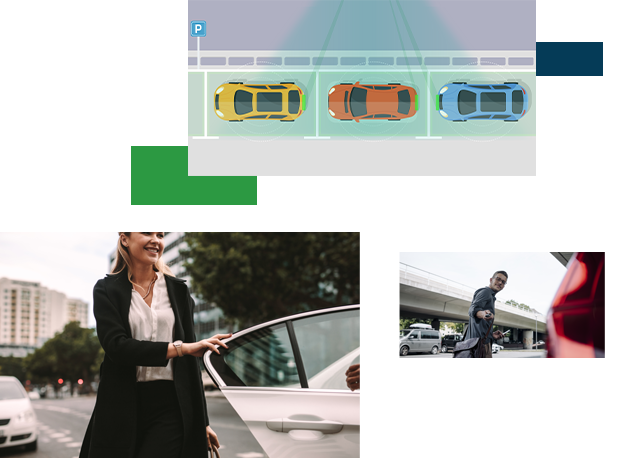The Future of Parking

For nearly a century, the fundamentals of parking remained unchanged, relying on an array of physical tools: curbside coin meters, paper citations, and permitting that required written applications and window decals. Today, however, consumers expect more digital, touchless experiences in all that they do. Fortunately, the technology now exists for parking authorities to meet those expectations and better support motorists, staff, revenue goals, and smart city initiatives.
Through the Camera Eye – the Power of Automated, Always-On Image Capture
Camera-based enforcement technology has long been used for violation identification in the tolling, red light, and speed infraction arenas. With toll authorities transitioning from human-staffed tollbooths to gantry-mounted cameras and vehicle transponders that automate motorist invoicing, the results have been freer-flowing roads and better motorist CX.
This type of technology, however, is still relatively new in the parking management space. There are many operational use cases that can bring safer, more efficient experiences for motorists, pedestrians, staff, and businesses:
Meter spaces
Permit zones
Loading zones
Bus stops
Bus lanes
Bike lanes
Safety zones (crosswalks, hydrants, turn lanes, etc.)
Transportation network company (TNC) pickups/drop-offs
Lots
Ramps
Smart camera technology also enables authorities to manage parking assets with real-time precision that is impossible to achieve through traditional, manual enforcement methods.
Bringing these principles to parking programs, smart cameras allow for a “meter-less parking” ecosystem, enabling motorists to pay for public parking spaces through prepaid accounts. Just as motorists can use toll roads without stopping to pay tolls, drivers can park in public spaces without feeding meters or paying by phone.
How it Works
While the form factors and use cases for space coverage can vary, the fundamentals are the same:
Step 1: cameras begin capturing photos as soon as a vehicle enters a space or zone, tagging the data with the date and with entry and exit times. Cameras can be mounted curbside on poles, buildings, or other fixed structures. They also can be affixed on vehicles (e.g., public transit buses) to capture violations in real time as the vehicles follow their routes
Step 2: the photos serve as the evidence from which license plate recognition (LPR) can then be performed. Using LPR software, authorities and their partners can precisely identify vehicles parked in designated spaces for specific durations.
Step 3: the captured violation data and LPR results are then used for back-end processing (noticing, account debiting, permit verification, collection, towing, etc.).
From start to finish, this new parking experience is streamlined and digital, mirroring the other simple, seamless transactions people now expect in their day-to-day lives. Autonomous enforcement also helps boost compliance, as motorists come to understand the new “always on” monitoring and enforcement paradigm.
Benefits
Autonomous enforcement platforms afford many benefits for agencies and motorists.
Benefits for agencies include:
In real time, determine if a car is parked in a space and provide occupancy information to the public
Identify which car is parked in a space, including any associated payment, permit, permission, and offender statuses
Maximize revenue – and compliance – through precise, rapid, and consistent invoicing
Improve curbside safety and accessibility for pedestrians, bus passengers, and bikers
Conduct virtual “meter-bagging”
Manage loading zones and TNC transactions
Make informed policy decisions based on robust, accurate data and analytics
Automate vehicle identification and other processes that today require tedious, time-consuming manual intervention
Influence congestion and occupancy with dynamic pricing
Easily administer discount programs for designated groups (e.g., low-income residents, seniors, students, staff)
Lower operational and maintenance costs
Reduce auto exhaust emissions by streamlining on-street staff activities and minimizing the need for motorist circling and spot hunting
Remove meters, kiosks, and other cumbersome street furniture from high-traffic curb areas
Benefits for motorists include:
In real time, access space availability information and make reservations
Enjoy more convenient, familiar, safe, accessible, and mobile-friendly CX
Save time with “park and walk” experiences, rather than circling for spaces and fumbling with manual payments
More easily find and use designated spots for disabled motorists and other groups
Partner with Duncan to bring autonomous enforcement to your program
Duncan helps municipalities bring powerful, scalable autonomous enforcement solutions to their streetscapes. We can help you too, by:

Unifying your transaction, occupancy, and enforcement data to form a true picture of your program’s performance.

Measuring and tracking your system-wide compliance information to better understand and improve the health of your downtown area.

Managing and optimizing your enforcement operations to support your overall curb management strategy.

Give you the insights and analytics you need to make data-driven decisions about rates, inventory, duration, enforcement activity, and other key program elements.
Here are two examples of how we are activating these solutions for our clients:
We partner with leading providers to implement mobile, end-to-end enforcement platforms for both parking and moving violations. For example, we integrate with partners that mount photo and video hardware on city buses to capture robust, accurate, and real-time evidence packages for bus lane, bus stop, and bike lane violations. Leveraging our expert people and systems, we then review and process the violation information and manage subsequent steps including DMV lookups, registered owner identification, multichannel noticing, collections, and reporting. Depending on each client’s preferences, we customize a unique combination of human verification and robotic process automation throughout the workflows.

Through other projects and partnerships, we also provide "ticket by mail" solutions, building on our roadmap to a "park and walk" experience in downtown parking settings.
Across our autonomous enforcement activations, our proven, high-quality DMV registered owner retrieval services – trusted by 600+ government agencies to process 30M+ DMV registered owner transactions annually – ensure optimum accuracy and revenue for our clients.
Contact us to explore your autonomous enforcement opportunities, including pilot programs you can run in select zones, blocks, and neighborhoods.